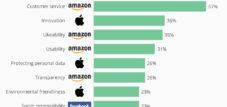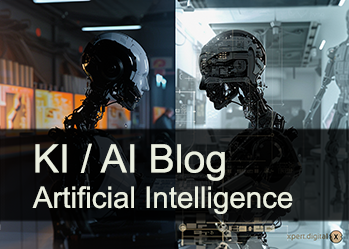The dirty truth behind the AI battle of the economic giants: Germany's stable model versus America's risky tech bet
Xpert pre-release
Language selection 📢
Published on: August 6, 2025 / Updated on: August 6, 2025 – Author: Konrad Wolfenstein

The dirty truth behind the AI battle of the economic giants: Germany's stable model versus America's risky tech bet – Image: Xpert.Digital
The Achilles heel of the tech giants: Why the Silicon Valley model is surprisingly fragile
Digital Dominance versus Industrial Resilience: A Comparative Analysis of Global Economic Models in the Age of AI
The battle for interpretive sovereignty and market positioning
The global economic landscape is at a crossroads where the battle for supremacy is no longer decided solely by traditional metrics such as production volumes or trade balances. Rather, a more subtle but all the more decisive competition has developed: the battle for the dominant position in the interpretation of what creates value in the economy of the 21st century and which economic models are sustainable. It is a struggle for narrative control and strategic market positioning, the outcome of which is by no means decided. On the one hand, there is the Silicon Valley narrative, which preaches an unstoppable digital transformation, led by a small group of technology giants whose innovations are portrayed as indispensable and without alternative. On the other hand, there is the often overlooked but enduring resilience of the industrialized nations, whose strength is rooted in physical production, engineering, and long-established value chains.
This report addresses the key questions arising from this tension. Is the digital economy, as driven by the United States, a self-sustaining force, or is it rather a complex superstructure resting on a foundation of physical matter, energy, and global supply chains? What are the real costs and dependencies of this digital infrastructure, often portrayed as intangible and "clean"? And which economic model is ultimately better equipped for long-term stable and sustainable prosperity: the speed- and risk-oriented, digital-centric approach of the United States, or the stability and permanence-oriented, industrially driven model of Germany and Europe?
Examining these questions reveals that the current economic competition between the major economic blocs – the US, the EU, and China – is increasingly being played out on a meta-level. It is no longer just about the direct competition of products and services, but about the strategic shaping of global narratives about what constitutes "innovation" and "value." The media dominance of the so-called "Magnificent Seven" and their tireless propagation of "irreplaceable AI" is not a coincidence, but a deliberate strategy to equate their digital products with progress itself and to make any alternative appear backward. The battle is being waged over the perception of one's own indispensability. The economic model that prevails in this narrative struggle will not only gain market share but also attract global capital, the most talented workforce, and favorable regulation. It is about defining the blueprint for the future.
Suitable for:
- Is Silicon Valley overrated? Why Europe's old strength is suddenly worth its weight in gold again – AI meets mechanical engineering
The anatomy of two economic models: USA/California vs. EU/Germany
What characterizes Silicon Valley's speed- and risk-oriented economic model?
The economic model, which has its origins and epicenter in Silicon Valley, can aptly be described as "fast and risky." It is based on a culture that prioritizes exponential growth and rapid scaling above all else, viewing failure not as a flaw but as a necessary learning step on the path to success. The primary goal is often not to build a company that will last for generations, but rather a quick, profitable "exit" through an IPO or sale, which generates immense returns for the founders and early investors.
The fuel for this model is a highly developed and massive venture capital (VC) ecosystem. The US VC market is orders of magnitude ahead of the European one. In 2022, venture capital investments totaled approximately €77 billion in Europe, compared to €188 billion in the US – roughly two and a half times more. Per capita, the gap is even greater. This enormous financial firepower makes it possible to invest in high-risk, visionary ideas and scale companies at a speed that is difficult to replicate in Europe's rather risk-averse financial culture. This culture of high risk-taking permeates the entire system, from investors to founders, employees, and regulators.
A direct consequence of this model is an extreme concentration of market power. The technology companies known as the "Magnificent Seven" – , Microsoft, Nvidia, Amazon, Alphabet, Meta, and Tesla – now account for over a third of the total value of the S&P 500 Index. This concentration is both a source of strength, as these few companies drive market returns, and a source of fragility, as it makes the entire market vulnerable to the performance of a handful of players.
The labor market also reflects this model. It is characterized by high flexibility and less stringent employment protection laws. This facilitates the rapid hiring and firing cycles typical of startups, but stands in sharp contrast to the German model, which emphasizes job security and stability.
What are the strengths of the German and European economy based on stability and long-term prospects?
In contrast to the American model, the German and, to a large extent, the European economy is based on the principles of stability, long-term sustainability, and substantial value creation. The backbone of this economic structure is the Mittelstand (small and medium-sized enterprises). More than 99 percent of all companies in Germany are small and medium-sized enterprises (SMEs), which employ almost 60 percent of the workforce and account for 82 percent of apprenticeships. These companies are often family-owned for generations, prioritize long-term stability over short-term profit maximization, and are deeply rooted in their local and regional communities.
A particular strength within the SME sector are the so-called "hidden champions." These are highly specialized companies, often unknown to the general public, that are global market leaders in their respective niche markets in the business-to-business sector. It is estimated that there are around 1,600 such companies in Germany alone. They contribute significantly to Germany's enormous export strength by focusing on quality, technological leadership, and innovation rather than competing on price.
The German innovation model differs fundamentally from that of Silicon Valley. It relies on consistent, incremental improvements based on in-depth engineering expertise and close integration of research, development, and production. A key success factor here is the dual training system, which produces a highly qualified workforce essential for implementing complex manufacturing processes.
The prevailing corporate culture is characterized by a certain risk aversion and a strong need for security. This is expressed in a cautious approach to financing – many SMEs shy away from external capital – and a business strategy focused on continuity. While this attitude can be a weakness in fast-moving digital markets, it proves to be a remarkable strength in times of economic uncertainty and global crises, ensuring stability and resilience.
How do these differences manifest themselves in fundamental economic data?
The fundamental differences between the Californian and German economic models are clearly reflected in the macroeconomic data. While California, as the world's fifth-largest economy, is often compared to Germany, a closer look at the sectoral composition of their gross domestic products (GDP) reveals a profound divergence.
California's economy, with a GDP of approximately $4.1 trillion in 2024, is dominated by services and the technology sector. The largest contributors to GDP are the professional and business services ($548.9 billion), information ($475.7 billion), and real estate ($446.3 billion). Manufacturing accounts for only about 11 percent. In contrast, Germany, whose GDP is forecast to reach approximately $4.7 trillion in 2025, has a much stronger industrial base. The industrial sector contributes approximately 28.1 percent to GDP, with the share of pure manufacturing, at just under 20 percent, almost twice that of California.
These structural differences continue in research and development (R&D) spending. Germany invests 3.1 percent of its GDP in R&D, an internationally leading figure. These investments are heavily concentrated in core industries: the automotive industry alone invested almost €30 billion in 2022, followed by mechanical engineering and the electronics industry. California's R&D landscape, on the other hand, is dominated by the technology giants, whose spending is primarily focused on software, artificial intelligence, and digital services, as demonstrated by the massive investments of the "Magnificent Seven" in AI chips and R&D.
The labor market also paints a clear picture of this divergence. In Germany, approximately 21.1 percent of the workforce is employed in manufacturing, underscoring the central role of industry in employment. In California, however, the largest employers are the health and social services sectors, followed by retail and professional, scientific, and technical services, reflecting the service- and knowledge-based orientation of the local economy. The following table provides a comparative summary of the key figures.
Labor market prospects: Industry-led Germany versus knowledge-based California

Labor market prospects: Industry-driven Germany versus knowledge-based California – Image: Xpert.Digital
The labor market outlook reveals a clear contrast between industry-driven Germany and knowledge-based California. While Germany's gross domestic product (GDP) is estimated at around $4.7 trillion in 2025, California's GDP will be approximately $4.1 trillion in 2024. Per capita GDP in California is significantly higher at around $104,058 than in Germany, where it is around $55,911. Manufacturing accounts for approximately 20% of GDP in Germany, compared to only about 11% in California. In contrast, the information and technology sector accounts for more than 30% of GDP in California, primarily driven by Silicon Valley, while this sector is significantly smaller in Germany at around 4.5%. Research and development spending is 3.1% of GDP in Germany, while it is unspecified but high in California. In terms of employment, approximately 8 million people work in the manufacturing sector in Germany, representing a 21.1% share, while in California, approximately 1.18 million people work in this sector. The IT sector employs approximately 1.18 million people in Germany, compared to approximately 1.35 million in California.
Analyzing these two economic models leads to a deeper understanding of their respective vulnerabilities. The US model, geared toward speed and risk, and the German model, focused on stability and longevity, are not only different; they are evolving in path-dependent ways that create critical, mutually exclusive vulnerabilities. The US model's focus on software and digital services makes it highly efficient in a stable world but extremely vulnerable to disruptions in the physical world, such as supply chains or energy supplies. Its hardware value chain is globalized and exposed; the entire model relies on a stable physical world that it does not control. The German model's strength, in contrast, lies in its control over high-value physical production. Its weakness is a cultural and structural aversion to the high-risk, rapid digital innovation that is now reshaping manufacturing itself, as exemplified by the concept of Industry 4.0. This creates a higher-order risk: the core strength of one model is the critical weakness of the other. The US lacks industrial resilience; Germany lacks digital agility. In a future characterized by both geopolitical instability disrupting physical supply chains and rapid technological change upending industrial processes, neither model is optimally positioned. The winner will be the economy that can best synthesize both approaches – a challenge that lies at the heart of the German "Industry 4.0" initiative.
🎯🎯🎯 Benefit from Xpert.Digital's extensive, fivefold expertise in a comprehensive service package | R&D, XR, PR & SEM

AI & XR-3D-Rendering Machine: five times expertise from Xpert.digital in a comprehensive service package, R&D XR, Pr & SEM – Image: Xpert.digital
Xpert.Digital has in-depth knowledge of various industries. This allows us to develop tailor-made strategies that are tailored precisely to the requirements and challenges of your specific market segment. By continually analyzing market trends and following industry developments, we can act with foresight and offer innovative solutions. Through the combination of experience and knowledge, we generate added value and give our customers a decisive competitive advantage.
More about it here:
Lobbying and Narratives – The Power of the “Magnificent Seven”: How Big Tech Controls the Public and Politics
The invisible hand of influence: actors and their interests
What influence do the “Magnificent Seven” have on public perception and political decision-making?
The influence of the "Magnificent Seven" – , Microsoft, Nvidia, Amazon, Alphabet, Meta, and Tesla – extends far beyond their economic market power. They actively shape public perceptions and political decisions through a combination of media dominance, targeted lobbying, and strategic control of the narrative surrounding technology and progress.
Their omnipresence in the financial and technology media creates a self-reinforcing hype cycle. Every product announcement, every quarterly figure, is intensely analyzed and disseminated, creating a climate of inevitability regarding their technological leadership. This narrative positions artificial intelligence as an unstoppable and indispensable force and its developers as the sole pioneers of this progress. Interestingly, public trust in the technology sector as a whole, at 76 percent, is significantly higher than trust in AI technology itself, which is welcomed by only 30 percent of people and rejected by 35 percent. Companies exploit this trust gap to build acceptance for their new AI products based on their established reputation.
Behind the scenes, they underpin this narrative influence with massive financial power in the political arena. The technology industry is now the sector with the highest lobbying expenditures in the European Union, spending over €97 million annually. A third of this sum, around €32 million, is accounted for by ten companies alone, including Google, Amazon, Apple, Microsoft, and Meta. This immense financial power gives them privileged access to political decision-makers. For example, during the drafting of the EU Digital Services Act, 75 percent of the European Commission's high-level meetings were with industry lobbyists.
This lobbying effort not only aims to prevent regulation, but actively shapes it in their own interests. Leaked documents have revealed strategies aimed at sowing conflict within the EU Commission in order to weaken legislation. Big Tech publicly advocates for "soft rules" that they themselves help shape, while portraying stricter regulations as a threat to small and medium-sized enterprises and consumers. This influence is concretely evident in the weakening of the EU AI Act's Code of Conduct. In the US, lobbying expenditures are even higher; total spending in 2022 amounted to over $4.1 billion, compared to around $110 million in the EU, highlighting the dimensions of this political influence.
What role do management consultants and bureaucracy play as systemic brakes on efficiency?
In addition to the direct influence of technology companies, there are two other systemic forces that act as brakes on efficiency and innovation, particularly in the German and European context: the management consulting industry and deeply rooted bureaucracy.
The business model of management consultancies is fundamentally based on making themselves indispensable to their clients. Critics argue that this is often not achieved by sustainably solving problems, but by creating new levels of complexity that ensure continued demand for consulting services. Often, they sell standardized products and methods that lack in-depth local or industry-specific knowledge, creating a dependency that weakens the client organization's internal capabilities and virtually "infantilizes" governments.
Particularly in the public sector, consultants are often used to lend external legitimacy to politically unpopular decisions such as downsizing or privatizations, or to serve as scapegoats when the measures fail. The track record of success is questionable. A quantitative study of the UK's National Health Service (NHS) found a significant positive correlation between consulting spending and organizational inefficiency. Although the use of consultants in the public sector is lower in Germany at 9 percent of revenue than in the UK at 22 percent, the same basic dynamics apply.
At the same time, German bureaucracy acts as a significant brake on growth. An overwhelming majority of 92 percent of German companies report having perceived an increase in bureaucratic burden over the past five years. This has concrete consequences: 58 percent of companies plan to avoid future investments in Germany due to bureaucracy. This burden results from the sheer volume of laws – the volume of federal legislation has grown by 60 percent in 15 years – as well as lengthy approval procedures, which can take four to five years for renewable energy projects, for example, and a significant digitalization lag in public administration. This creates a risk-averse environment that stifles the agility necessary for innovation. Recent reforms such as the "Fourth Bureaucracy Relief Act" aim to remedy this by digitizing contracts and shortening retention periods. However, companies remain skeptical: only 10 percent expect any noticeable relief, suggesting that the problem is deeply rooted in the administrative culture.
These two phenomena – the consultants' business model and the nature of bureaucracy – interact perniciously. Bureaucracy, with its complex processes and regulatory labyrinths, creates the problems that consultants are hired to solve. Consultants are hired by both the private sector to navigate the bureaucracy and the public sector to "reform" it. However, the "solutions" implemented by consultants often consist of new frameworks, metrics systems, and process models that add an additional layer of complexity rather than addressing the root cause. This creates a self-reinforcing cycle: Bureaucracy creates demand for consultants, whose solutions, in turn, can feed the bureaucratic machine. The result is a state of permanent, costly "transformation" without fundamental simplification. This dynamic actively counteracts the "fast and risky" innovation model and cements the "slow and steady" – even stagnant – status quo.
Suitable for:
- The central contradiction: Deburocratization, advise on the profiteers of bureaucracy – the error in the system of bureaucracy reduction
The physical reality of the digital world: dependencies and costs
Why is the digital economy fundamentally dependent on physical production?
The idea of an immaterial, weightless digital economy is one of the most powerful fictions of the 21st century. In truth, the digital economy is inextricably linked to the physical world and fundamentally dependent on material production. A data center without a productive economy whose processes it can optimize is economically pointless. Its value only arises from the application of its computing power to real processes in manufacturing, logistics, trade, or services. A factory could and can theoretically exist without a cloud connection; however, a data center cannot monetize its value without a factory, logistics company, or retailer it serves. Digitization is thus not a substitute for physical value creation, but rather a multiplier of it.
This dependence is most clearly manifested in the physical infrastructure upon which the entire digital world is built. Every email, every stream, every AI algorithm is processed on physical hardware: on servers, routers, and switches housed in data centers, and on endpoint devices such as smartphones and laptops. The rise of artificial intelligence, in particular, is driving a massive expansion of this physical infrastructure, as AI models require immense computing power.
A critical tension arises from the different speeds at which digital and physical infrastructures can be built. A modular data center can be constructed in just two to three months, while building a modern factory takes several years. This asymmetry carries the risk of misinvestments and market cannibalization. When digital capacity grows faster than the physical economy's ability to utilize and pay for that capacity, overcapacity and unprofitable digital infrastructures emerge. The digital and physical economies must grow in lockstep to ensure a stable system.
What material resources and global supply chains underpin the digital infrastructure?
The physical foundation of digital infrastructure is itself the result of complex, global, and resource-intensive supply chains that are subject to significant geopolitical risks.
At the heart of every digital hardware device is the semiconductor. Its manufacturing is a highly complex process that relies on a global supply chain of raw materials, including a variety of rare earth elements such as gallium, germanium, neodymium, and cerium. These elements are essential for the specific electrical and magnetic properties of microchips.
However, the rare earth supply chain is a geopolitical bottleneck. China dominates this market to an overwhelming extent. The country is responsible for approximately 60 percent of global production but around 90 percent of the processing of these critical minerals. This dominance gives Beijing considerable geopolitical leverage, as demonstrated by the imposition of export restrictions on gallium and germanium. The United States and its allies, such as Australia and Brazil, are making strenuous efforts to build alternative supply chains, but this is a lengthy and capital-intensive process that will take years, if not decades.
The end products of these supply chains, such as a smartphone, are masterpieces of global logistics. An iPhone, for example, consists of components that originate from all over the world: displays from South Korea, memory chips from Japan, processors designed in the USA but manufactured in Taiwan, and final assembly that often takes place in China or Vietnam. This highly efficient yet extremely fragile system is vulnerable to disruptions caused by geopolitical tensions, natural disasters, or trade conflicts, as recent years have clearly demonstrated. The digital world thus relies on a stable network of physical commodity flows that can break at any time.
What are the ecological costs of digitalization?
The narrative of the "clean" digital economy obscures the enormous and ever-increasing ecological costs associated with its physical infrastructure. Digitalization has a massive material footprint that extends across its entire life cycle – from raw material extraction to production and operation to disposal.
Data centers, often trivialized as "the cloud," are among the most energy-intensive buildings of all, consuming 10 to 50 times more energy than a typical office building. In 2023, they accounted for 4.4 percent of total electricity consumption in the U.S. Fueled by the insatiable energy demands of AI applications, this share is forecast to rise to 9 to 12 percent by 2030. At the same time, they are immense consumers of water. A single large data center can require up to 5 million gallons (approximately 19 million liters) of water per day for its cooling systems, placing a severe strain on water resources in already arid regions.
Semiconductor manufacturing is also an ecologically problematic process. Chip fabrication is extremely resource-intensive and responsible for a significant portion of the electronics industry's greenhouse gas emissions. A single plant can consume up to 10 million gallons (approximately 38 million liters) of ultrapure water daily, using a variety of hazardous chemicals. These include fluorinated gases with high global warming potential and so-called "forever chemicals" (PFAS), which can permanently contaminate water sources. Silicon Valley itself is now home to numerous "Superfund sites," highly contaminated areas resulting from the legacy of the semiconductor industry.
At the end of its life cycle, digital hardware becomes electronic waste (e-waste), the fastest-growing solid waste stream in the world. In 2022, 62 million tons of e-waste were generated worldwide. Less than a quarter of this is properly recycled. The remainder ends up in landfills, is incinerated, or illegally exported to developing countries. There, valuable metals are often recovered under the most primitive conditions, such as burning cables in the open air or using acid baths. This process releases highly toxic substances such as lead, mercury, and dioxins, causing severe and lasting damage to human health and the environment.
Ecological costs of digitalization
The ecological costs of digitalization are manifold. Data centers in the US will account for 4.4% of total electricity consumption in 2023, with a forecast of 9% to 12% in 2030. The water consumption of a large data center can be as high as 19 million liters per day. In semiconductor manufacturing, water consumption per factory is as high as 38 million liters per day. In addition, greenhouse gases such as perfluorocarbons (PFCs), SF6, and NF3, as well as toxic chemicals such as PFAS, arsenic, and acids, are produced. The carbon footprint of smartphone production is approximately 57 kilograms of CO2 equivalent. In 2022, 62 million tons of electronic waste were generated worldwide, of which only 22.3% was documented to have been recycled.
The prevailing narrative of a "clean" or "dematerialized" digital economy proves, upon closer examination, to be a dangerous misconception. The digital world has a massive and rapidly growing physical and ecological footprint. However, this is largely externalized – both geographically, by shifting dirty production and disposal processes to other regions of the world, and temporally, by burdening future generations with the costs of waste disposal and climate change mitigation. The term "the cloud" itself is a marketing gimmick that obscures the reality of massive, energy- and water-hungry industrial facilities. The true costs of the digital revolution are not fully reflected in the balance sheets of technology companies. This "ecological debt" represents a hidden subsidy for the digital economy, paid for by the communities near mines, factories, and e-waste dumping sites, as well as by the global climate.
🔄📈 B2B trading platforms support – strategic planning and support for export and global economy with Xpert.digital 💡
Business-to-business (B2B) trading platforms have become a critical component of global trade dynamics and thus a driving force for exports and global economic development. These platforms offer companies of all sizes, in particular SMEs – small and medium -sized companies – that are often regarded as the backbone of the German economy, significant advantages. In a world in which digital technologies come to the fore more and more, the ability to adapt and integrate is crucial for success in global competition.
More about it here:
Between Silicon Valley and Mittelstand: Europe's Opportunities in Techno-Industrialism
The future of value creation
Is the Silicon Valley model overrated and Europe's industrial strength undervalued?
The preceding analysis suggests that the prevailing narrative has overemphasized the strengths of the Silicon Valley model and underemphasized those of the European, particularly German, industrial economy. The undeniable strength of the American model lies in its capacity for rapid, disruptive innovation and exponential scaling. However, this strength comes at the cost of significant, often overlooked weaknesses: a fundamental dependence on fragile global supply chains for physical hardware, a massive and growing ecological footprint, and the creation of extreme market concentration that poses systemic risks.
In contrast, Europe's industrial base offers remarkable resilience. The close integration of research, development, and high-quality production, a highly trained skilled workforce, and a corporate culture focused on long-term stability are valuable assets in an increasingly uncertain and volatile world. The decentralized structure of Germany's Mittelstand also promotes a broader regional distribution of wealth and prevents the extreme geographical concentration of wealth characteristic of Silicon Valley.
However, the verdict is not final, and no model is inherently superior to the other. The crucial insight is that for too long, the debate has been characterized by a one-sided fascination with the purely digital, while the importance of material value creation has been neglected. The future likely belongs neither to one extreme nor the other, but rather to a hybrid model that combines the speed of innovation of digital with the resilience, quality, and sustainability of advanced manufacturing.
Suitable for:
- In truth, the Magnificent 7, according to estimates, ensure a US trade surplus of EUR 112 billion (2023) to the EU
What opportunities does the synthesis of AI and mechanical engineering open up for Germany as an industrial location (Industry 4.0)?
Germany's strategic response to the challenges of digitalization is the concept of "Industry 4.0." It describes the vision of an intelligent factory ("Smart Factory") in which machines, products, and IT systems are interconnected in real time. This enables highly customized production at the cost of mass production, forward-looking maintenance to prevent downtime, and resource-efficient, flexible logistics.
This vision is no longer a distant dream. Leading German industrial companies are already implementing AI solutions in their manufacturing processes. Siemens, for example, uses AI to optimize its supply chains, for quality control, and for forward-looking maintenance of its plants, reporting significant efficiency gains and a reduction in downtime. BMW is using AI in vehicle design and to control robots on the assembly line to increase precision and efficiency.
A key advantage for Germany is the close collaboration between industry and excellent research institutions such as the Fraunhofer-Gesellschaft. These collaborations ensure the rapid transfer of fundamental AI research into practical applications for production. Studies by the Fraunhofer Institute show that AI adoption in German industry is progressing – around 16 percent of industrial companies already use AI – but is currently still concentrated in large companies and specific sectors such as the automotive industry.
The greatest challenge, and at the same time the greatest opportunity, lies in the widespread implementation of Industry 4.0 among German SMEs. SMEs often face significant hurdles, including a lack of expertise, difficulties integrating new technologies into existing legacy systems, data protection concerns, high investment costs, and the lack of a clear digitalization strategy. If these hurdles can be overcome, Germany could create a unique economic model that combines the strengths of its industrial base with the benefits of digital transformation.
Suitable for:
What strategic course must be set for a sustainable and stable market economy?
In order to create a sustainable and stable market economy, both economic models must address their respective systemic weaknesses and make strategic decisions.
The primary challenge for Germany and the EU lies in overcoming structural inertia. This requires a concerted effort to reduce bureaucracy, accelerate approval processes, and facilitate investment. A more risk-tolerant innovation culture must be fostered and access to growth capital improved to narrow the gap with the US VC market. Above all, the digitalization of SMEs must be accelerated through targeted funding programs, the expansion of digital infrastructure, and the strengthening of digital skills. The goal must not be to copy Silicon Valley, but to create a unique "Made in Digital Germany" model that builds on existing industrial strengths.
The challenge for the US and Silicon Valley is to acknowledge and address the inherent fragilities and externalized costs of their model. Specifically, this means increasing the resilience of supply chains through reshoring or near-shoring critical hardware manufacturing. It requires massive investments in a circular economy for electronics to address the growing e-waste crisis and reclaim valuable raw materials. And it demands that tech giants assume greater responsibility for the massive energy and environmental impact of their digital infrastructure and stop passing these costs on to society as hidden costs.
At the global level, the imperative is to recognize the inevitable symbiosis between the digital and physical worlds. A sustainable future requires a balanced approach that equally values bits and atoms, innovation and resilience, rapid growth and long-term stability. The decisive competitive advantage of the future will not lie in prioritizing one over the other, but in mastering their intelligent and responsible integration.
The simultaneous crises of geopolitical instability, climate change, and technological disruption are rendering both the purely digital and the traditional industrial model in their current form obsolete. Geopolitical tensions, particularly with China, are exposing the fragility of the US model's globalized hardware supply chains. The climate crisis and scarcity of water and energy resources are exposing the enormous, unsustainable footprint of the digital economy and challenging its "clean" image. At the same time, the rapid advances in AI threaten to render the German industrial model uncompetitive if it fails to adapt quickly enough due to cultural and bureaucratic inertia. None of the existing models is robust enough to withstand all these stresses simultaneously. A purely digital economy is neither resilient nor sustainable. A purely industrial economy that fails to digitize is uncompetitive. This convergence of crises is forcing the evolution toward a new economic paradigm: a "resilient, sustainable techno-industrialism." This new model must prioritize resilience through diversified, more localized supply chains; sustainability through a circular economy and low-carbon energy for digital and physical production; and deep techno-industrial integration through the embedding of AI and digital tools directly into advanced manufacturing, as envisioned by the Industry 4.0 vision. This is the strategic endpoint to which the entire analysis points.
Your global marketing and business development partner
☑️ Our business language is English or German
☑️ NEW: Correspondence in your national language!
I would be happy to serve you and my team as a personal advisor.
You can contact me by filling out the contact form or simply call me on +49 89 89 674 804 (Munich) . My email address is: wolfenstein ∂ xpert.digital
I'm looking forward to our joint project.




























